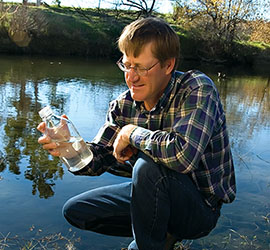WIFSS Director Receives Award
Chris Brunner, June 10, 2014
 Rob Atwill, Director of Veterinary Medicine Extension at UC Davis and the Western Institute for Food Safety and Security; and Ken Tate, the Rustici Endowed Chair in Rangeland Watershed Science and UC Cooperative Extension Specialist in the Department of Plant Sciences at UC Davis, are the recipients of the UC Agriculture and Natural Resource 2013-14 Outstanding Team Award. Over the past two decades Atwill and Tate have collaborated on numerous projects regarding the potential risk to drinking and recreational surface water quality from livestock and wildlife and the subsequent impact on human health.
Rob Atwill, Director of Veterinary Medicine Extension at UC Davis and the Western Institute for Food Safety and Security; and Ken Tate, the Rustici Endowed Chair in Rangeland Watershed Science and UC Cooperative Extension Specialist in the Department of Plant Sciences at UC Davis, are the recipients of the UC Agriculture and Natural Resource 2013-14 Outstanding Team Award. Over the past two decades Atwill and Tate have collaborated on numerous projects regarding the potential risk to drinking and recreational surface water quality from livestock and wildlife and the subsequent impact on human health.
Following the 1993 Milwaukee outbreak of waterborne cryptosporidiosis, drinking water districts and public health agencies in California grew increasingly concerned about the risk of waterborne infectious diseases from livestock grazing on coastal, foothill, and Sierra Nevada watersheds. This concern reached the point that agencies such as the San Francisco Public Utilities Commission, Metropolitan Water District of Southern California, and the East Bay Municipal Utility District proposed substantial reductions of all grazing on the assumption that livestock herds were defecating unacceptable amounts of the protozoal parasite, Cryptosporidium parvum, into surface water sources. Legislation was being developed to ban cattle and horses from rangeland in the watersheds of various major reservoirs in California. Some of this concern was driven by the emergence of HIV, AIDS and the serious infection that C. parvum could cause in this cohort of the public.
Both Atwill and Tate were hired in 1994 and began collaborating soon afterwards on the complex ecology of livestock grazing, rangeland water quality, and the fate and transport of waterborne zoonotic diseases such as C. parvum and Giardia duodenalis. In close cooperation with ANR advisors and UC faculty, the two crafted an interdisciplinary research and outreach program that developed beneficial management practices (BMPs) that could be used by private land owners, municipal water districts, public health agencies, and resource conservation districts to mitigate these and other waterborne hazards. The challenge was to develop practical BMPs that were not only effective and adoptable, but also provided a degree of balance between the numerous ecosystem services we expect from our California watersheds, such as safe and potable water, affordable grazing opportunities, wildlife biodiversity, and recreational water quality.
Over the years their research has developed numerous assessment methods and intervention strategies for quantifying and minimizing the risk of a wide variety of waterborne contaminants from livestock, humans and wildlife on watersheds located from the Sierra Nevada Mountains, agricultural valleys, to coastal communities along southern, central and northern California. Their work has resulted in a collection of over 300 peer-reviewed papers, proceedings, technical reports and abstracts, in addition to delivering over 400 workshops, seminars, and field days for communities concerned about waterborne contaminants from animal agriculture, human activity, and wildlife populations.
